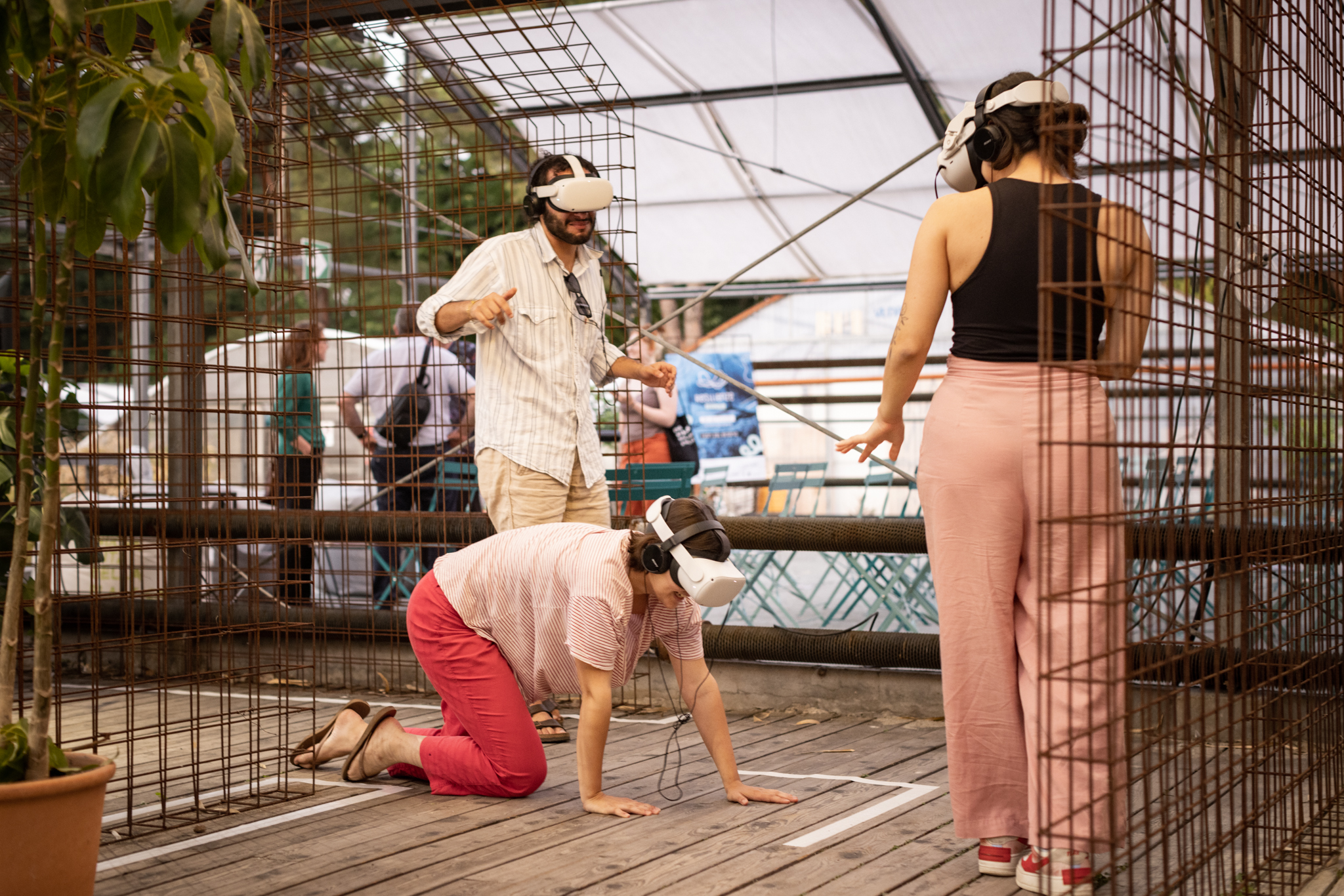
The artwork Becoming-with explores links between real and virtual, physical and digital.
Crédits photos : Anna Pompermaier & Cenk Güzelis
Cenk Güzelis, with Anna Pompermaier, both architects and artists, are presenting their work at Recto VRso 2023 edition. The art digital festival highlights hybridations between real and virtual. That’s precisely the topic of the artists’ artwork, Become-with, which calls for virtual wanders in our real body.
Can you introduce yourself?
I am an architect, researcher, and media artist based in Innsbruck, Austria, currently holding a position as a faculty member and PhD fellow at ./studio3, the Institute for Experimental Architecture, in Innsbruck University. My design projects, teaching, and research examine hybrid modes of spatiality and embodied telepresence through performative new media installations revolving around online culture, ubiquitous computing, post-human critique, and spatial internet.
Anna Pompermaier is an architect, media artist, researcher and lecturer at ./studio3, the Institute for Experimental Architecture of Innsbruck University. Her artistic research and practice investigate the influences of immersive technologies on our everyday experiences and interpersonal interactions in the upcoming livable domains. Through XR multisensorial installations, she explores multi-layered materialities, hybrid assemblages, and new relationships between humans and non-humans following the post-human and new materialism theories.
Why did you choose technology to make art?
Coming from the field of experimental architecture and research, we naturally introduced new media technologies into our artistic practice to explore hybrid modes of spatiality. We artistically approach the applications of spatial computing technologies in experimental social scenarios to explore these technologies’ influences on our everyday experiences and interpersonal interactions in our upcoming livable domains.
You already exhibited at a previous edition of Recto VRso. What does the festival mean to you?
We are very excited and honored to be part of the 2023 edition of the Recto VRso Festival. The last edition, where Anna participated as a solo artist with her project Meet Me Halfway, was a fantastic opportunity to discover many stimulating projects and connect with various institutions.
The Recto VRso festival always uses exhibition locations that are out of the ordinary (a chapel in 2022, a school-museum in 2019, a virtual world in 2020…). Does the place influence the way you exhibit and the scenography of your work?
We initially developed the project Becoming-with – encounters in an augmented garden as a site-specific mixed-reality installation exploring human and non-human encounters in an augmented contact zone at the Giardini Margherita in Bologna (IT). In our artistic practice, we often start from the physical space to then expand and connect it to different locations in social mixed-reality and multiuser installations.
Our installations often work with physical objects and sculptures that connect the user’s body through different realities and guide them in navigating the space. Due to the nature of mixed reality allowing simultaneously physical and digital environments overlayed onto each other, users can access the virtual space while retaining their physical presence. Not being cut off from their physical and social selves, visitors have a strong sense of presence and engagement within the installation.
Can you describe the new artwork you will exhibit at Recto VRso 2023?
Becoming-with explores human and non-human encounters in an augmented garden contact zone. It creates a multiuser and multisensory extended reality experience in which the human body becomes-with a fabulative generated ecology. Becoming-with is a place to slow down, change pace, and get entangled in the environment, natural and artificial, digital and physical, hosting novel digital becomings.
Becoming-with investigates an inclusive virtual-physical public place, where human and non-human relationships and speculative hybridizations stimulate the flourishing of new ways of seeing, perceiving and being in the world and allow unexpected encounters. By adopting the posthuman understanding of the notion of becoming-with, the project illustrates a hybrid parallel garden in a fully-bodied mixed reality experience that turns the visitors into live digital entities.
The new digital-natural garden becomes a space for multispecies coexistence and unexpected encounters where physical and digital materialities diffuse into each other to create a hybrid multisensorial explorative experience. Touch, gaze, gestures, smell, and dialogues become the locus in this experience where visitors’ presence in virtual space, namely their virtual bodies, turn into hybrid species dissolving into the ecology of the digital garden as they explore it.
You won a Laval Virtual Award during a previous edition. What did it mean to you as an artist?
Winning the Award during the past edition brought excellent visibility to the Meet Me Halfway project, which was then exhibited at various Festivals and invited for speeches and conferences.
Do you try to deliver a message through your works?
At the intersection between art,research and architecture, we explore the spatial, cultural and social relationships of design, new media technologies and artificial intelligence. For example, our upcoming project Be My Guest!, will become a mixed-reality dinner-event experience, present simultaneously in the physical and in the virtual, combining spatial-storytelling, AI-driven design, ubiquitous computing, and posthuman theories to open a ground for discussion about the emerging socio-cultural role of artificial intelligent models and the integration of new media technologies in our everyday social scenarios and interpersonal interactions for the future of our liveable domains.
How did technologies change the relationship between the artwork and the spectator?
The mediums of virtual and mixed reality are spatial – they create a spatial image: the users move away from being mere observers and have the novel opportunity to step into the picture. Even more: these technologies have the transformative force to submerge the viewer from a passive state of observation into an active role of interaction and participation. They allow them to bypass the representative level of the artwork and let it act on their pre-linguistic body: the spectator becomes the user and participant.

